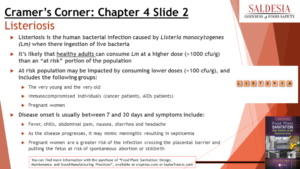Listeriosis
 Per Michael Cramer, “Last week we described the conditions for Listeria monocytogenes (Lm)to thrive in our manufacturing environment. This is the organism that is responsible for the disease listeriosis and is responsible for approximately 1,600 illnesses and 260 deaths in the US annually. While healthy adults may consume foods that are adulterated with Lm, it is the “at risk” population described in Cramer’s Corner Chapter 4 Slide 2 that are most susceptible to the organism. This may be the reason why the U.S. maintains a “zero tolerance” for Lm in foods while other countries have adopted a limit of <100 cfu/g.
Per Michael Cramer, “Last week we described the conditions for Listeria monocytogenes (Lm)to thrive in our manufacturing environment. This is the organism that is responsible for the disease listeriosis and is responsible for approximately 1,600 illnesses and 260 deaths in the US annually. While healthy adults may consume foods that are adulterated with Lm, it is the “at risk” population described in Cramer’s Corner Chapter 4 Slide 2 that are most susceptible to the organism. This may be the reason why the U.S. maintains a “zero tolerance” for Lm in foods while other countries have adopted a limit of <100 cfu/g.
It is important to recognize that the U.S food industry has done a good job in reducing the incidence of Lm over the last 20 years, manufacturers, particularly those making RTE foods, must continually assess the conditions in their facility and implement stringent Lm control protocols These are presented in detail in Chapter 4 of the book Food Plant Sanitation, entitled “Control of Listeria in Food Manufacturing”.”
Slide Content
Listeriosis is the human bacterial infection caused by Listeria monocytogenes (Lm) when there ingestion of live bacteria
It’s likely that healthy adults can consume Lm at a higher dose (≈1000 cfu/g) than an “at risk” portion of the population
At risk population may be impacted by consuming lower doses (<100 cfu/g), and includes the following groups:
– The very young and the very old
– Immunocompromised individuals (cancer patients, AIDs patients)
– Pregnant women
Disease onset is usually between 7 and 30 days and symptoms include:
– Fever, chills, abdominal pain, nausea, diarrhea and headache
– As the disease progresses, it may mimic meningitis resulting in septicemia
– Pregnant women are a greater risk of the infection crossing the placental barrier and putting the fetus at risk of spontaneous abortion or stillbirth
